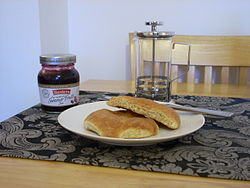A rowie, also known as a buttery or Aberdeen roll, is a savoury bread roll originating from Aberdeen, Scotland.
 | |
| Alternative names | Buttery, rowie, Aberdeen roll |
|---|---|
| Type | Bread roll |
| Place of origin | Aberdeen, Scotland |
| Main ingredients | Flour, lard, butter or vegetable oil, yeast |
Origin
editLegend has it that the rowie was made for the fishermen sailing from Aberdeen harbour. The theory is that they needed a bread that would not become stale during the two weeks or more that they were at sea. The high fat content meant the bread also provided an immediate energy source.[1]
Rowies are typically made from flour, butter, lard, salt, sugar and yeast.[2][3][4] However, concerns have been raised about major commercial producers swapping the traditional butter and lard mixture for palm oil.[5]
Serving
editButteries are noted for their flaky texture and buttery taste, similar to that of a croissant, and slight saltiness. They are often toasted and served with jam or butter, golden syrup or plain with tea, although the high fat content makes them extremely hot when toasted.[6][7][8]
As the alternative name of Aberdeen roll suggests, butteries are a speciality of Aberdeen but they are common throughout the Northeast of Scotland and are available worldwide.[9]
Articles in the Aberdeen Journal from early in the 19th century bemoan the increased use of lard in place of butter in traditional "butter rolls".[10] In 1917 when restrictions were placed on the sale of bread owing to World War I, butteries were exempt, enabling Aberdeen bakers to continue to produce rowies. The exemption was rescinded a few months later but appeals were made on the grounds that butteries were an intrinsic "part of the food of the working classes in industrial centres."[11] Aberdeen City Food Control Committee continued to challenge the validity of the restriction two years later in February 1919.[12]
In 2006 a buttery was offered for sale on eBay during a fund raising for the Royal Aberdeen Children's Hospital; the successful bidder, Enterprise Engineering, paid £620 for it.[13]
Radio and TV presenter Sir Terry Wogan once memorably described eating a buttery as like having a "mouth full of seaweed".[14]
World Buttery Championship
editThe first ever World Buttery Championships took place on Saturday, 16 June 2018 at the Aberdeen campus of North East of Scotland College.
The competition was organised by Martin Gillespie on behalf of Slow Food Aberdeen City and Shire to celebrate the Traditional Buttery being 'boarded' on the Slow Food Ark of Taste.
10 finalists took part in a live bake-off and the results were judged in a blind taste test with Mark Barnett, of Gold'N'Crispy, New Pitsligo being crowned the winner.
On 11 November 2024 the World Buttery Championship was revived, again at the Aberdeen campus of North East of Scotland College, and this time the competition was split into two categories.
The Retail Baker category was for bakers who sell their products to the public and after a stiff competition Mark Barnett retained his title very closely followed by Iryna Porfilova, of Bakes You Knead, Forres and Shona Jamieson of The Highlander Bakehouse, Ballater.
The Home Bake category provided those who do not sell their products with the opportunity to bake off and find the best home baked buttery. Here the winner was Jane Hay from Oldmeldrum with runners up Coleen Reid from Aberchirder and Stuart Sproul from Nairn.
Organisers, Slow Food Aberdeen City & Shire plan for the World Buttery Championship to return in June 2026.
See also
editReferences
edit- ^ "Aberdeen butteries". Information Britain. Archived from the original on 29 April 2014. Retrieved 29 April 2014.
- ^ Ross, Peter (5 July 2018). "Utterly buttery: the Scottish pastries 'that look like roadkill croissants'". The Guardian. ISSN 0261-3077. Retrieved 5 March 2020.
- ^ "Aberdeen butteries (Rowies)". BBC Food. Retrieved 5 March 2020.
- ^ "A Buttery Delight! by Norman Harper". True Highlands. 28 May 2015. Retrieved 5 March 2020.
- ^ Ross, Peter (5 July 2018). "Utterly buttery: the Scottish pastries 'that look like roadkill croissants'". The Guardian. ISSN 0261-3077. Retrieved 5 March 2020.
- ^ packet information from J G Ross Buttery 4 pack. "Ingredients: Wheatflour,Water,Vegetable Oil,Sugar,Animal Fat,Yeast,Salt,Emulsifier (E471, E322), Natural Vegetable Colours (E160b/E100), Flavouring." Tesco.com website accessed 14 June 2010
- ^ Aberdeen Butteries 4 pack ingredients list states "Non Hydrogenated Vegetable Fat,Vegetable Oils" Tesco.com website accessed 14 June 2010
- ^ Redpath, Laura. "17 things you might not know about Aberdeen rowies". Press and Journal. Retrieved 5 March 2020.
- ^ Redpath, Laura (28 August 2014). "17 things you might not know about Aberdeen rowies". The Press and Journal. Retrieved 4 May 2019.
- ^ "Glimpses of Olden Days in Aberdeen", w.William Buchanan p. The Aberdeen Journal 1870 "Aberdeen 50 years ago" - page 11
- ^ "The Buttery Rowie, threat to Aberdeen's morning delicacy". Evening Express. No. 12222. 27 August 1917. p. 2 – via British Newspaper Archive.
- ^ "Food committee and fish prices, buttery rowie again". Aberdeen Journal. No. 20011. 19 February 1919. p. 4 – via British Newspaper Archive.
- ^ "Aberdeen rowie sells for £620 on eBay". The Scotsman. 24 April 2006. Archived from the original on 29 April 2014. Retrieved 29 April 2014.
- ^ Redpath, Laura. "17 things you might not know about Aberdeen rowies". Press and Journal. Retrieved 5 March 2020.